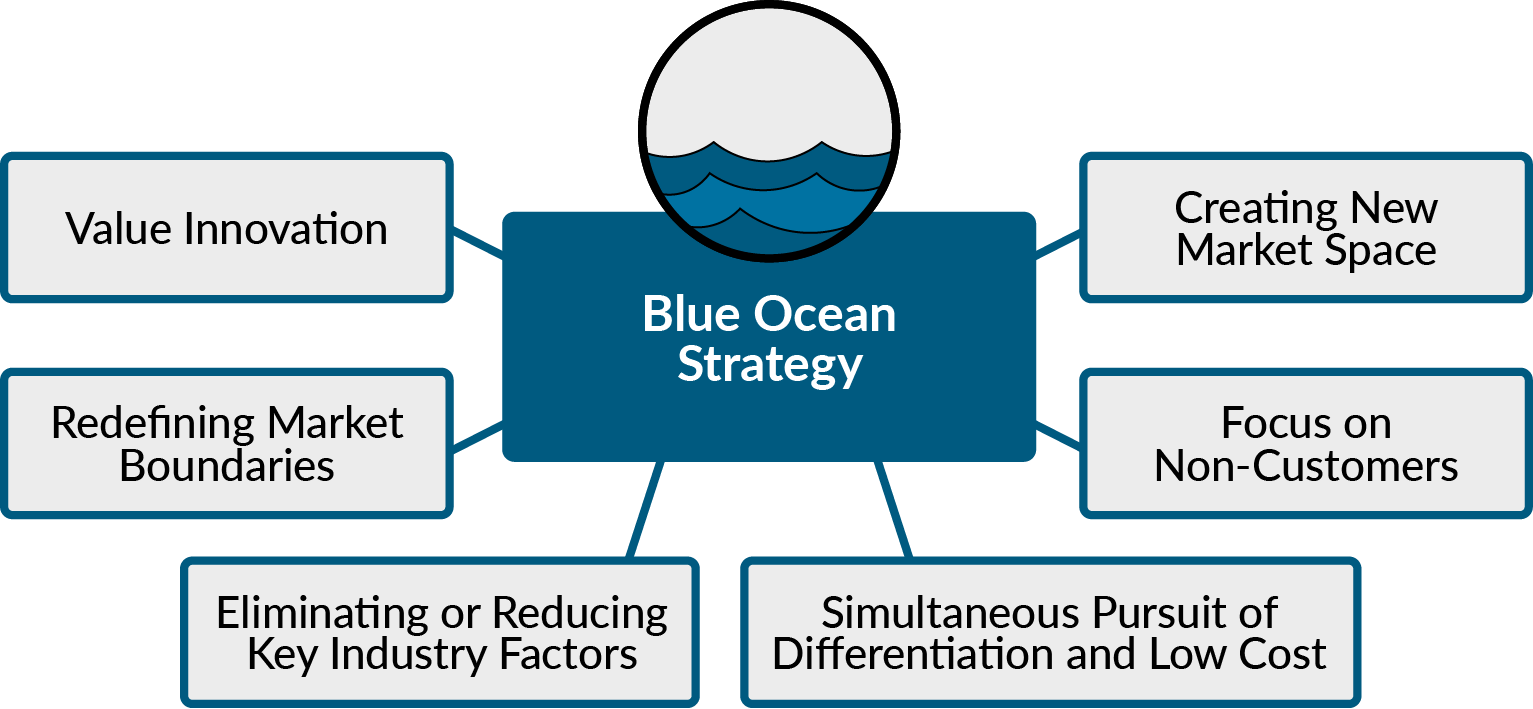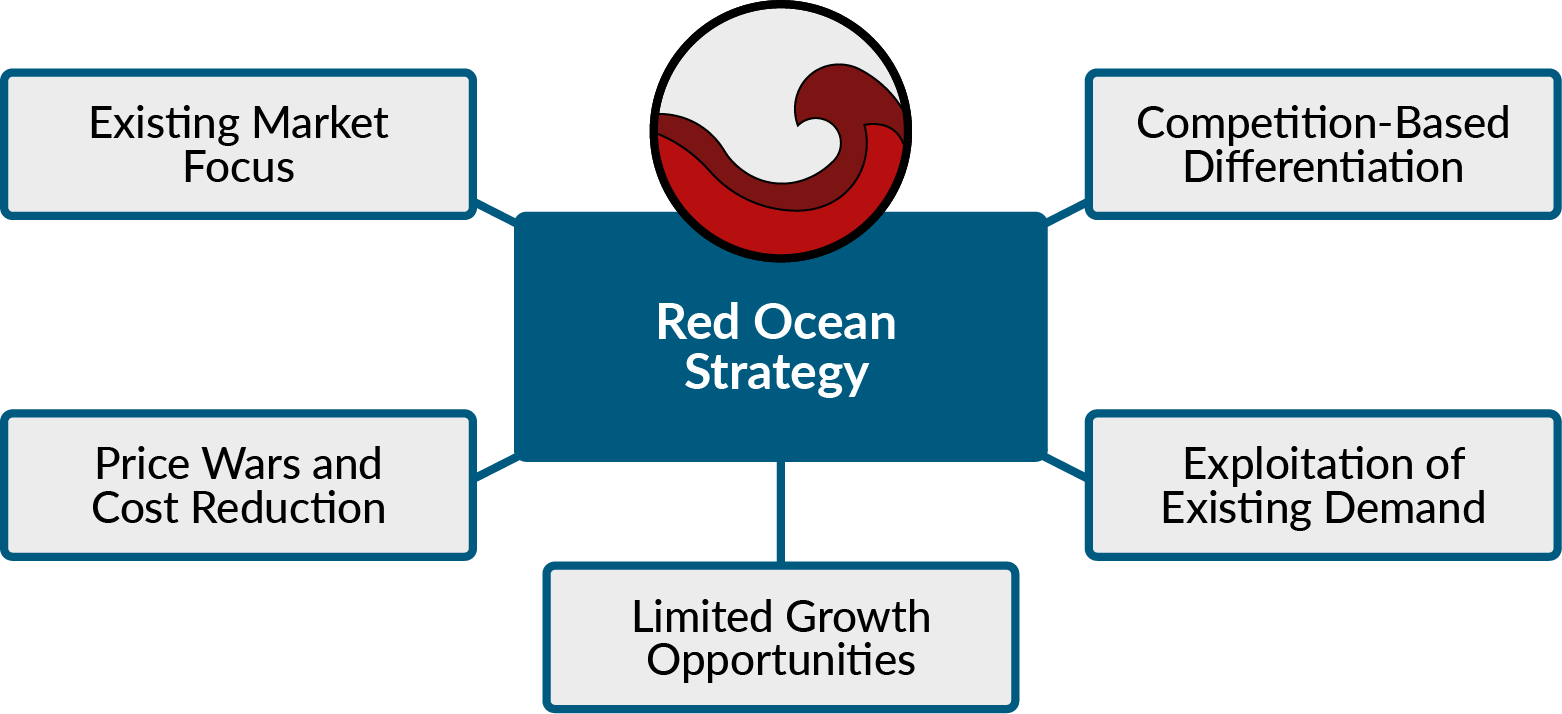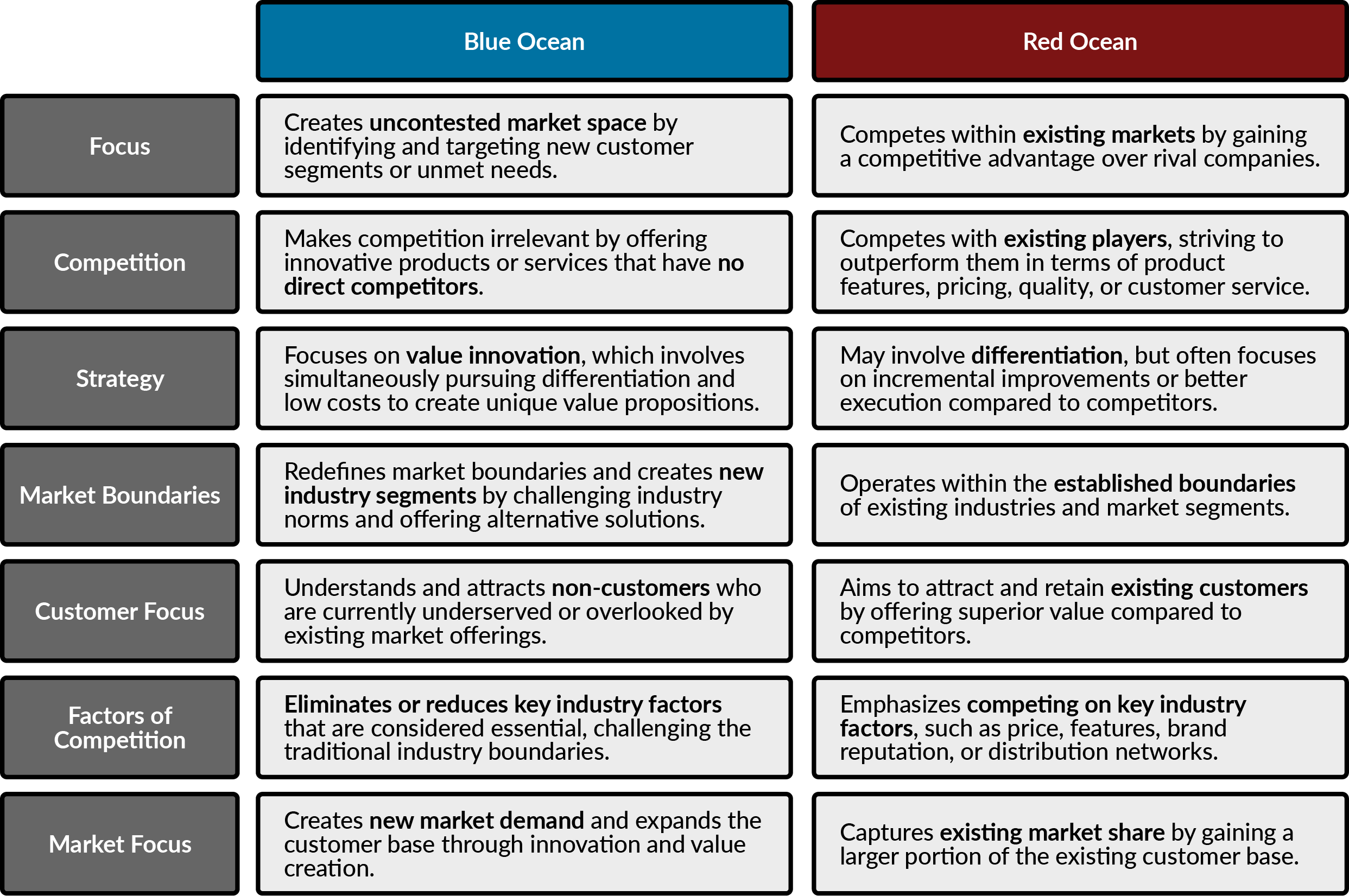Blue and Red Ocean Strategy
Red Ocean Strategy and Blue Ocean Strategy are two distinct approaches in strategic management. In the competitive business landscape, the Red Ocean Strategy represents the traditional environment where companies fiercely compete in existing markets, often leading to intense rivalry and limited growth opportunities. On the other hand, the Blue Ocean Strategy encourages organizations to chart a different course by creating new market spaces through innovative products or services that stand apart from existing offerings. By venturing into unexplored territory and establishing uncontested market spaces, companies can break free from cutthroat competition and discover new avenues for sustainable growth. In this course, we will delve deeper into both strategies to gain a comprehensive understanding of their principles and practical applications
Blue Ocean Strategy
Blue Ocean Strategy is a concept developed by W. Chan Kim and Renée Mauborgne in their book “Blue Ocean Strategy: How to Create Uncontested Market Space and Make the Competition Irrelevant.” It is a strategic approach that focuses on creating new market spaces with little or no competition rather than competing in existing markets with fierce competition (referred to as the “red ocean”).
Blue Ocean Strategy is connected to competitive strategies as it provides an alternative perspective for companies to achieve sustainable growth and success. Instead of engaging in head-to-head competition within an existing market, companies following the Blue Ocean Strategy seek to create uncontested market space by offering innovative products or services that attract new customers and cater to unmet needs.
Key principles and characteristics of the Blue Ocean Strategy include:

- Value Innovation: Blue Ocean Strategy emphasizes the concept of value innovation, which involves simultaneously pursuing differentiation and low-cost strategies. By offering unique value to customers while achieving cost efficiency, companies can create new market demand and capture untapped opportunities.
- Creating New Market Space: Blue Ocean Strategy encourages companies to explore new market spaces where competition is limited or nonexistent. This involves identifying unmet customer needs, industry pain points, and alternative customer groups that are currently overlooked or underserved.
- Redefining Market Boundaries: Instead of competing within the boundaries of existing industries, Blue Ocean Strategy encourages companies to challenge industry norms and redefine market boundaries. This may involve offering a new combination of features, incorporating innovative technologies, or rethinking the value proposition to create a leap in value for customers.
- Focus on Non-Customers: Blue Ocean Strategy emphasizes the importance of understanding non-customers, those who are not currently served by existing products or services in the market. By identifying the reasons why non-customers are not engaged and addressing their needs and preferences, companies can expand their customer base and create new demand.
- Eliminating or Reducing Key Industry Factors: Blue Ocean Strategy encourages companies to identify and eliminate or reduce the factors that have traditionally been considered essential in the industry. By challenging the status quo and offering alternative solutions, companies can differentiate themselves and create a competitive advantage.
- Simultaneous Pursuit of Differentiation and Low Cost: Blue Ocean Strategy challenges the conventional wisdom that differentiation and low cost are mutually exclusive. It suggests that companies can pursue both by making strategic trade-offs, leveraging technology, and rethinking the value chain to create a cost structure that supports differentiation.
Blue Ocean Strategy offers a systematic approach for companies to break free from the constraints of existing market competition and create new value propositions that attract customers and drive growth. By focusing on innovation, value creation, and redefining market boundaries, companies can pursue a path of sustainable competitive advantage and market leadership.
Red Ocean Strategy
The distinction between Red Ocean and Blue Ocean Strategies was introduced in the book “Blue Ocean Strategy: How to Create Uncontested Market Space and Make the Competition Irrelevant” by W. Chan Kim and Renée Mauborgne. They presented the idea that companies can break away from fierce competition in Red Oceans by creating new market spaces or “Blue Oceans” where competition is less relevant or even nonexistent. “Red Ocean,” also known as competitive strategy, is commonly used to describe traditional competitive markets with high levels of competition, derived from the metaphor of a bloody ocean where competitors fight for a limited market share.
Red Ocean is characterized by intense rivalry, competing for market share, and maximizing existing demand within well-defined industry boundaries. In the red ocean, companies strive to outperform their competitors by offering similar products or services but at better prices, higher quality, or with better features.
Key characteristics of the Red Ocean Strategy include:

- Existing Market Focus: Companies competing in the red ocean primarily focus on existing markets and industries where competition is already established. They aim to capture market share from their competitors rather than creating entirely new markets.
- Competition-Based Differentiation: Differentiation in the red ocean is typically based on factors such as price, quality, features, or customer service. Companies seek to gain a competitive advantage by offering superior value within the boundaries of existing market demand.
- Price Wars and Cost Reduction: In the red ocean, price competition is common, and companies often engage in price wars to attract customers. Cost reduction becomes crucial to maintain profitability and gain a competitive edge.
- Exploitation of Existing Demand: Red Ocean Strategy focuses on capturing a larger share of existing market demand by providing incremental improvements or variations on existing products or services.
- Limited Growth Opportunities: Since companies in the red ocean compete within established markets, growth opportunities can be limited. The emphasis is on gaining a larger share of the existing market rather than creating new market demand.
Understanding the Red Ocean Strategy is essential because it highlights the challenges and limitations of competing in established markets. It emphasizes the need for companies to differentiate themselves effectively and find ways to stand out amidst intense competition.
Here’s a comparison of the Blue Ocean Strategy (creating uncontested market space) and Red Ocean Strategy (competing in existing markets) within the context of competitive strategies:

In summary, Blue Ocean Strategy seeks to create new market space by offering innovative and unique value propositions to attract new customers, while Red Ocean Strategy focuses on competing within existing markets by outperforming competitors and capturing a larger share of the existing customer base. Blue Ocean Strategy emphasizes differentiation, value innovation, and market boundary redefinition, while Red Ocean Strategy emphasizes competition, incremental improvements, and capturing market share within existing industry boundaries.
Let’s look at a case study illustrating the application of the Red Ocean Strategy and Blue Ocean Strategy for MonChlo, a fictional company operating in the cosmetics industry.
Case Study: MonChlo – Red Ocean Strategy

MonChlo is a well-established cosmetics company that operates in a highly competitive market. The industry is saturated with numerous players offering similar products, and MonChlo faces intense competition, price wars, and limited growth opportunities. To maintain its position in the market, MonChlo adopts a Red Ocean Strategy.
MonChlo focuses on maximizing its existing market share by differentiating its products through innovative formulations, high-quality ingredients, and effective marketing campaigns. The company invests in extensive market research to understand customer preferences and develops new product lines that cater to specific customer needs. MonChlo also engages in aggressive pricing strategies to gain a competitive advantage over rivals and attract price-conscious consumers.
To maintain profitability and sustain its position in the market, MonChlo emphasizes cost control and operational efficiency. The company optimizes its supply chain, streamlines production processes, and negotiates favourable contracts with suppliers. By managing costs effectively, MonChlo can offer competitive prices while maintaining quality standards.
Despite operating in a Red Ocean environment, MonChlo faces challenges such as limited market growth and fierce competition. To overcome these challenges, the company continuously monitors market trends, invests in research and development, and leverages customer feedback to refine its product offerings. MonChlo also explores partnerships and collaborations with key retailers and influencers to expand its reach and gain access to new customer segments.
Case Study: MonChlo – Blue Ocean Strategy

Recognizing the limitations of the Red Ocean Strategy, MonChlo decides to explore new avenues for growth by adopting a Blue Ocean Strategy. The company aims to create uncontested market spaces and differentiate itself from competitors through innovation and value creation.
MonChlo conducts a thorough analysis of customer needs and identifies unmet demands within the cosmetics industry. Through this analysis, they discover a growing segment of environmentally conscious consumers who prioritize sustainable and natural beauty products. MonChlo seized this opportunity to develop a line of eco-friendly and cruelty-free cosmetics, positioning itself as a pioneer in the market.
By focusing on sustainable ingredients, recyclable packaging, and transparent sourcing, MonChlo differentiates itself from competitors and taps into a Blue Ocean of environmentally conscious customers. The company creates a unique value proposition by offering a combination of high-quality, natural products that align with the values of its target customers.
To further establish its position in the Blue Ocean, MonChlo leverages digital marketing and social media platforms to raise awareness and engage with its target audience. The company collaborates with influencers and beauty bloggers who share its commitment to sustainability, gaining credibility and expanding its customer base.
By adopting a Blue Ocean Strategy, MonChlo successfully creates a new market space where competition is minimal. The company experiences rapid growth as it captures the attention of environmentally conscious consumers who are seeking ethical and sustainable beauty alternatives. MonChlo’s innovation and commitment to sustainability set it apart from traditional cosmetics brands, allowing it to thrive in an uncontested market.
This case study demonstrates the application of both the Red Ocean Strategy and Blue Ocean Strategy in the cosmetics industry, showcasing how MonChlo leverages competitive strategies to navigate the challenges of a saturated market while also creating new market spaces for growth.